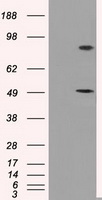PSMC3 Mouse Monoclonal Antibody [Clone ID: OTI7B10]
CAT#: TA500931
Anti-PSMC3 mouse monoclonal antibody, clone OTI7B10 (formerly 7B10)
Size: 30 ul
Formulation: Carrier-Free
USD 436.00
USD 200.00
USD 867.00
Specifications
| Product Data | |
| Clone Name | OTI7B10 |
| Applications | FC, IF, WB |
| Recommended Dilution | WB 1:2000, IF 1:100, Flow 1:100 |
| Reactivities | Human, Mouse, Rat |
| Host | Mouse |
| Isotype | IgG1 |
| Clonality | Monoclonal |
| Immunogen | Full length human recombinant protein of human PSMC3(NP_002795) produced in HEK293T cell. |
| Formulation | PBS (pH 7.3) containing 1% BSA, 50% glycerol and 0.02% sodium azide. |
| Concentration | 0.57 mg/ml |
| Purification | Purified from mouse ascites fluids or tissue culture supernatant by affinity chromatography (protein A/G) |
| Conjugation | Unconjugated |
| Storage | Store at -20°C as received. |
| Stability | Stable for 12 months from date of receipt. |
| Predicted Protein Size | 49.2 kDa |
| Gene Name | proteasome 26S subunit, ATPase 3 |
| Database Link | |
| Background | The 26S proteasome is a multicatalytic proteinase complex with a highly ordered structure composed of 2 complexes, a 20S core and a 19S regulator. The 20S core is composed of 4 rings of 28 non-identical subunits; 2 rings are composed of 7 alpha subunits and 2 rings are composed of 7 beta subunits. The 19S regulator is composed of a base, which contains 6 ATPase subunits and 2 non-ATPase subunits, and a lid, which contains up to 10 non-ATPase subunits.Proteasomes are distributed throughout eukaryotic cells at a high concentration and cleave peptides in an ATP/ubiquitin-dependent process in a non-lysosomal pathway. An essential function of a modified proteasome, the immunoproteasome, is the processing of class I MHC peptides. This gene encodes one of the ATPase subunits, a member of the triple-A family of ATPases that have chaperone-like activity. This subunit may compete with PSMC2 for binding to the HIV tat protein to regulate the interaction between the viral protein and the transcription complex. A pseudogene has been identified on chromosome 9. |
| Synonyms | DCIDP; RPT5; TBP1 |
| Reference Data | |
| Protein Families | Druggable Genome, Transcription Factors |
| Protein Pathways | Proteasome |
Documents
| Product Manuals |
| FAQs |
| SDS |
Resources
| Antibody Resources |
Other Versions
| SKU | Description | Size | Price |
|---|---|---|---|
| CF500931 | Carrier-free (BSA/glycerol-free) PSMC3 mouse monoclonal antibody, clone OTI7B10 (formerly 7B10) |
USD 600.00 |
|
| TA500931AM | Anti-PSMC3 mouse monoclonal antibody, clone OTI7B10 (formerly 7B10), Biotinylated |
USD 509.00 |
|
| TA500931BM | Anti-PSMC3 mouse monoclonal antibody, clone OTI7B10 (formerly 7B10), HRP conjugated |
USD 509.00 |
|
| TA500931S | Anti-PSMC3 mouse monoclonal antibody, clone OTI7B10 (formerly 7B10) |
USD 200.00 |
{0} Product Review(s)
Be the first one to submit a review






























































































































































































































































 Germany
Germany
 Japan
Japan
 United Kingdom
United Kingdom
 China
China








